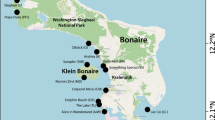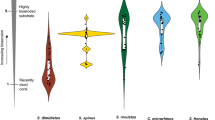Abstract
Marine hypersaline ponds on Anegada, British Virgin Islands contain stratigraphic evidence (Shell and Sand Sheet) of a A.D. 1650–1800 overwash event that could have formed through a hurricane or tsunami. Candidates for the deposit include far-field (e.g. 1755 Lisbon tsunami) and local Puerto Rico Trench events (e.g. 1690), but hurricanes cannot be ignored. The goal of this study is to provide additional information to assess the origin of the deposit by examining the taphonomic characters of Homotrema rubrum, a common encrusting foraminifer in Caribbean reef settings. Surface samples (n = 12) from major sub-environments (reef-flat, beach, storm wrack, and dune) and pond sections (n = 6; 20–80 cm thick) are analyzed for their Homotrema concentration (specimens/cm3) and taphonomic character. Particle-size analysis was conducted on the same sections and samples. Highly Preserved (red colored, angular, intact chambers) Homotrema dominate the beach, storm wrack, and reef-flat deposits relative to the dune sand, but the beach and storm wrack contain the largest specimens. The Shell and Sand Sheet in the pond has Highly Preserved and abundant Homotrema (specimens/cm3) versus other sedimentary units in the ponds (e.g. Mud Cap and Shelly Mud). Its taphonomic character is most similar (test size and condition) to the storm wrack deposit on the beach indicating an outside provenance for the sand. Concentration of Homotrema in the Shell and Sand Sheet declined southward indicating a northerly reef-flat provenance for the overwash, although it does not preclude a southern inundation as well. It is unclear whether Homotrema individuals originated from the reef itself or were eroded from older beach ridge deposits during the overwash event. Conclusions from Homotrema taphonomic analysis were limited by the lack of comparative data from known hurricane and tsunami deposits in other Caribbean regions.







Similar content being viewed by others
References
Atwater BF, ten Brink US, Buckley M, Halley RS, Jaffe BE, Lopez-Venegas AM, Reinhardt EG, Tuttle MP, Watt S, Wei Y (2010) Geomorphic and stratigraphic evidence for an unusual tsunami or storm a few centuries ago at Anegada, British Virgin Islands. Nat Hazards. doi:10.1007/s11069-010-9622-6
Brewster-Wingard GL, Ishman SE (1999) Historical trends in salinity and substrate in Central Florida Bay: a paleoecological reconstruction using modern analogue data. Estuaries 22:369–383
Buckley M, Wei Y, Jaffe J, Watt S (2011) Inverse modeling of velocities and inferred cause of overwash that emplaced inland fields of boulders at Anegada, British Virgin Islands. Nat Hazards. doi:10.1007/s11069-011-9725-8
Donato SV, Reinhardt EG, Boyce JI, Pilarczyk JE, Jupp BP (2009) Particle-size distribution of inferred tsunami deposits in Sur Lagoon, Sultanate of Oman. Mar Geol 257:54–64
Donnelly J (2005) Evidence of past intense tropical cyclones from backbarrier salt pond sediments: a case study from Isla de Culebrita, Puerto Rico, USA. J Coast Res 42:201–210
Dunn GE (1961) The hurricane season of 1960. Mon Weather Rev 89:99–108
Elliott JM, Logan A, Thomas MLH (1996) Morphotypes of the foraminiferan Homotrema rubrum (Lamarck): distribution and relative abundance on reefs in Bermuda. Bull Mar Sci 58:261–276
Emiliani C (1951) On the species Homotrema rubrum (Lamarck). Cushman Found Foram Res Spec Cont 2:143–147
Hawkes AD, Bird M, Cowie S, Grundy-Warr C, Horton BP, Tan Shau Hwai A, Law L, Macgregor C, Nott J, Eong Ong J, Rigg J, Robinson R, Tan-Mullins M, Tiong T, Yasin Z, Wan Aik L (2007) Sediments deposited by the 2004 Indian Ocean tsunami along the Malaysia–Thailand Peninsula. Mar Geol 242:169–190
Hippensteel SP, Martin RE (1999) Foraminifera as an indicator of overwash deposits, barrier island sediment supply, and barrier island evolution, Folly Island, South Carolina. Palaeogeogr Palaeoclimatol Palaeoecol 149:115–125
Horsfield WT (1975) Quaternary vertical movements in the Greater Antilles. Geol Soc Am Bull 86:933–938
Howard J (1970) Reconnaissance geology of Anegada Island. Caribbean Research Institute, St. Thomas, p 18
Hughen KA, Baillie MGL, Bard E, Beck JW, Bertrand CJH, Blackwell PG, Buck CE, Burr GS, Cutler KB, Damon PE, Edwards RL, Fairbanks RG, Friedrich M, Guilderson TP, Kromer B, McCormac G, Manning S, Ramsey CB, Reimer PJ, Reimer RW, Remmele S, Southon JR, Stuiver M, Talamo S, Taylor FW, van der Plicht J, Weyhenmeyer CE (2004) Marine04 marine radiocarbon age calibration, 0–26 cal kyr BP; IntCal04; calibration. Radiocarbon 46:1059–1086
Jarecki L, Walkey M (2006) Variable hydrology and salinity of salt ponds in the British Virgin Islands. Saline Syst 2. doi: 10.1186/1746-1448-2-2
Jones B, Hunter IG (1992) Very large boulders on the Coast of Grand Cayman: the effects of giant waves on rocky coastlines. J Coast Res 8:763–774
Kortekaas S, Dawson AG (2007) Distinguishing tsunami and storm deposits: an example from Martinhal, SW Portugal. Sediment Geol 200:208–221
Lopez AM, Stein S, Dixon T, Sella G, Calais E, Jansma P, Weber J, LaFemina P (2006) Is there a northern Lesser Antilles forearc block? Geophys Res Lett 33. doi:10.1029/2005GL025293
Machado AJ, Moraes SS (2002) A note on the occurrence of the encrusting foraminifera Homotrema rubrum in reef sediments from two distinctive hydrodynamic settings. Ann Brazilian Acad Sci 74:727–735
MacKenzie FT, Kulm LD, Cooley RL, Barnhart JT (1965) Homotrema rubrum (Lamarck), a sediment transport indicator. J Sed Res 35:265–272
Mamo B, Strotz L, Dominey-Howes D (2009) Tsunami sediments and their foraminiferal assemblages. Earth-Sci Rev 96:263–278
McCann W, Feldman L, McCann M (1984) Catalog of felt earthquakes for Puerto Rico and neighboring islands 1492–1899 with additional information for some 20th century earthquakes. Unpublished material provided as a pdf by the lead author, pp 122
Millás JC, Pardue L (1968) Hurricanes of the Caribbean and adjacent regions, 1492–1800. Academy of the Arts and Sciences of the Americas, Miami, Fla
Morton RA, Gelfenbaum G, Jaffe BE (2007) Physical criteria for distinguishing sandy tsunami and storm deposits using modern examples. Sediment Geol 200:184–207
Murray JW (1991) Ecology and palaeoecology of benthic foraminifera. Longman, Harlow, p 397
O’Loughlin KF, Lander JF (2003) Caribbean tsunamis: a 500-year history from 1498–1998. Kluwer Academic, Dordrecht, Boston, p 263
Park LE, Siewers FD, Metzger T, Sipahioglu S (2009) After the hurricane hits: recovery and response to large storm events in a saline lake, San Salvador Island, Bahamas. Quat Int 195:98–105
Pickering VW (1983) Early history of the British Virgin Islands: from Columbus to emancipation. Falcon Publications International, pp 248
Poag CW (1981) Ecologic atlas of benthic foraminifera of the Gulf of Mexico. Marine Science International, Woods Hole, MA
Reid HF, Taber S (1920) The Virgin Islands earthquakes of 1867–1868. Bull Seismol Soc Am 10:9–20
Reimer PJ, Baille MGL, Bard E, Bayliss A, Beck JW, Bertrand CJH, Blackwell PG, Buck CE, Burr GS, Cutler KB, Damon PE, Edwards RL, Fairbanks RG, Friedrich M, Guilderson TP, Hogg AG, Hughen KA, Kromer B, McCormac G, Manning S, Ramsey CB, Reimer RW, Remmele S, Southon JR, Stuiver M, Talamo S, Taylor FW, van der Plicht J, Weyhenmeyer CE (2004) IntCal04 terrestrial radiocarbon age calibration, 0–26 cal kyr BP; IntCal04; calibration. Radiocarbon 46:1029–1058
Reinhardt EG, Pilarczyk JE, Brown A (2011) Probable tsunami origin for a shell and sand sheet from marine ponds on Anegada, British Virgin Islands. Nat Hazards. doi:10.1007/s11069-011-9730-y
Sambridge M, Braun J, McQueen H (1995) Geophysical parametrization and interpolation of irregular data using natural neighbors. Geophys J Int 122:837–857
Scott DB, Collins ES, Gayes PT, Wright E (2003) Records of prehistoric hurricanes on the South Carolina coast based on micropaleontological and sedimentological evidence, with comparison to other Atlantic Coast records. Geol Soc Am Bull 115:1027–1039
Stein S (1982) Subduction seismicity and tectonics in the Lesser Antilles Arc. J Geophys Res 87:8642–8664
van Hengstum PJ, Reinhardt EG, Boyce JI, Clark C (2007) Changing sedimentation patterns due to historical land-use change in Frenchman’s Bay, Pickering, Canada: evidence from high-resolution textural analysis. J Paleolimnol 37:603–618
Wei Y, ten Brink US, Atwater BF (2010) Modeling of tsunamis and hurricanes as causes of the catastrophic overwash of Anegada, British Virgin Islands, between 1650 and 1800: Abstract OS42B-03. Presented at 2010 Fall meeting, American Geophysical Union, San Francisco, California, 13–17 December 2010
Zahibo N, Pelinovsky E, Yalciner AC, Kurkin A, Koselkov A, Zaitsev A (2003) The 1867 Virgin Island Tsunami. Nat Hazards Ear Sys Sci 3:367–376
Acknowledgments
The government of the British Virgin Islands permitted access to Anegada’s salt ponds, use of airphotos, and guidance from its specialists in disaster management, surveying, and natural science. Among them, we especially thank Cynthia Rolli, Rondell Smith, Shannon Gore, and Dylan Penn. Lianna Jarecki shared her comprehensive knowledge of Anegada’s salt ponds, Alejandra Rodriguez assisted with field work and Alyson Brown helped with laboratory work. Insightful comments from Brian Atwater and two anonymous reviewers greatly improved this manuscript. The work was supported in part by the Nuclear Regulatory Commission under its project N6480, a tsunami-hazard assessment for the eastern United States and an NSERC Discovery grant to ER.
Author information
Authors and Affiliations
Corresponding author
Rights and permissions
About this article
Cite this article
Pilarczyk, J.E., Reinhardt, E.G. Homotrema rubrum (Lamarck) taphonomy as an overwash indicator in Marine Ponds on Anegada, British Virgin Islands. Nat Hazards 63, 85–100 (2012). https://doi.org/10.1007/s11069-010-9706-3
Received:
Accepted:
Published:
Issue Date:
DOI: https://doi.org/10.1007/s11069-010-9706-3




